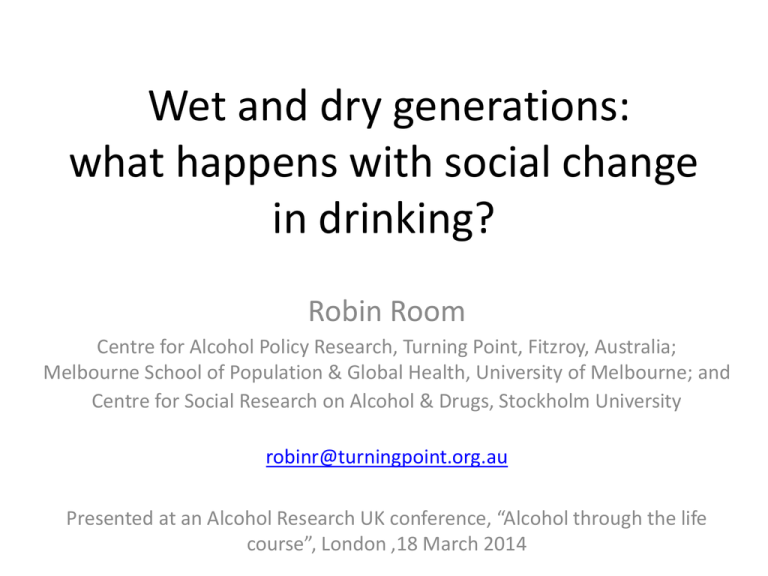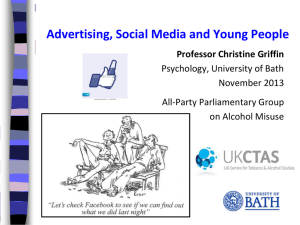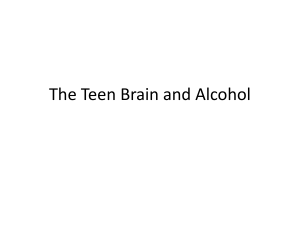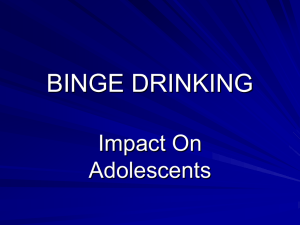Presentation slides - Alcohol Research UK
advertisement

Wet and dry generations: what happens with social change in drinking? Robin Room Centre for Alcohol Policy Research, Turning Point, Fitzroy, Australia; Melbourne School of Population & Global Health, University of Melbourne; and Centre for Social Research on Alcohol & Drugs, Stockholm University robinr@turningpoint.org.au Presented at an Alcohol Research UK conference, “Alcohol through the life course”, London ,18 March 2014 Historically, there have been big changes in drinking, some quite fast 1900-1913: A temperance high-point 1914-1918: Wartime 1939-1932: Depression 1960-1975: Postwar prosperity 1995-2005: Millenial boom Litres of pure alcohol consumption per capita in the UK, 1900-2006 [Tighe, A. (ed.) (2007) Statistical Handbook 2007, Brewing Publications] Italy 1970-2000: alcohol consumption is halved Factors include: *urbanisation, * industrialisation, * change in women’s status, * red wine as demerit peasant food, * EU agriculture policies rise in minimum price (A. Allamani & F. Prina, eds., Why the decrease in consumption of alcoholic beverages in Italy?... Contemp Drug Probs 34:187-378, 2007.) YEARS 1861-1870 1871-1880 1881-1890 1891-1900 1901-1910 1911-1920 1921-1930 1931-1940 1941-1950 1951-1960 1961 1965 1970 1975 1980 1985 1990 1995 2002 2003 SPIRITS WINE BEER LT. PURE LT. LT. ALCOHOL 83.9 90.4 95.4 89.2 119.6 112.1 112.7 88.2 74.8 100.6 108.2 110.1 113.7 104 92.9 75 62.5 55.7 51.0 50.5 0.2 0.4 0.7 0.5 1.1 2 3.3 1.3 1.7 3.7 6.1 8.6 11.3 12.8 16.7 21.9 25.1 25.4 28.2 30.1 0.4 0.4 0.8 0.6 0.5 0.5 0.6 0.2 0.4 0.9 1.2 1.4 1.8 1.8 1.9 1.3 1 0.8 0.4 0.8 TOTAL ALCOHOL LT. PURE ALCOHOL 10.5 11.3 12.3 11.3 14.9 14.0 14.3 10.8 9.4 13.1 14.4 15.0 15.9 14.8 13.7 11.2 9.5 9.2 7.4 7.4 Alcohol consumption in the US 1830s-1970s (indirect measures during Prohibition) (Moore & Gerstein, eds., Alcohol & Public Policy, National Academy Press, 1981) Waves of Temperance: 1840s, 1860-1880, 1910-1918 Upsurges: 1850s 1880-1910 1940-1980 Schematic diagram of factors influencing consumption levels Factors pushing down: Economic depression Total war footing Taxes Controls on availability/access Societal responses to problems Factors tending to stabilize: Cultural customs Habit-forming nature of drinking Factors pushing up: Rising purchasing power Deregulation Greater availability/access Advertising/promotion Level of alcohol consumption Factors pushing either way: Structural changes Drinking norms & cultural politics Social movements Adapted from: Room, Österberg, Ramstedt & Rehm, Explaining change & stasis in alcohol consumption. Addiction Research & Theory 17:562-576, 2009 An example of cultural change in drinking: U.S. college students 1900-1930 • Strong downward trend after 1900: – College student opinion turned against drinking: “a strong and increased questioning of the place and value of alcoholic liquors in the community and in personal use, because of their many unfortunate social consequences” -- Harry Warner, “Alcohol in college life: historical perspectives” in Maddox, ed., The Domesticated Drug (1970) • Reversal in the 1920s: – The age of “flappers: and the “roaring Twenties” Vanguards of the reversal: a minority in the generation born 1888-1900 Birthdates of American authors with reputations as heavy drinkers or alcoholics 1809 Edgar Allen Poe (Room, A ‘reverence for ....... strong drink’ J Stud Alc 1869 Edward A. Robinson 45:540-546, 1984) ....... 1876 Jack London ....... 1879 Wallace Stevens 1880 ........ 1885 Ring Lardner - Sinclair Lewis ....... 1888 Raymond Chandler - Eugene O’Neill 1889 Robert Benchley 1890 ....... 1892 Edna St. Vincent Millay 1893 J.J. Marquand - Dorothy Parker 1894 e.e. cummings -Dashiell Hammett 1895 Edmund Wilson 1896 F. Scott Fitzgerald 1897 William Faulkner ....... 1899 Hart Crane - Ernest Hemingway ....... 1900 Thomas Wolfe ....... 1902 John Steinbeck ....... 1905 John O’Hara ....... 1908 Theodore Roethke ....... 1910 ....... 1914 John Berryman - Tennessee Williams Approximate birthdates, those contributing stories to the “big book” of Alcoholics Anonymous 1st Edition (1939) 2nd Edition (1955) 1879 x x 1880 xx ....... 1882 x ....... 1888 xx x 1889 x 1890 x 1891 x ....... 1893 x ....... 1895 xx 1896 xxxxx xx 1897 xxx 1898 xx 1899 x 1900 xxxx xxx x 1901 x xx 1902 xx 1903 x 1904 x xx ....... 1906 x 1910 ....... 1914 x ....... 1917 x ....... 1928 x mean birth year: 1895 1903 (Room, Alcoholism and AA in U.S. films, 1945-1962. J Stud Alc 50:368-383, 1989) The vanguard born in 1888-1900 became the cultural heroes of and models for the next generation • “The present trend (1938) is a reversal of the trend of 100 years. It is toward a wider diffusion of drink practices and greater regularity among larger numbers. For a comparable situation one must turn back ... more than a century ago”. (Warner) • A new “subterranean ethic began to jell” by the mid1920s:... “one drank to become drunk, or, failing that, to appear drunk.... In addition, one drank in the company of and together with women”. -- P. Fass, The Damned & the Beautiful: American Youth in the 1920s. (1977) The dynamics of generational change: some hypotheses • The high-tide mark of drinking styles and patterns tend to be set in young adulthood (~18-26), at least in Anglophone societies • The cultural politics of drinking at the time of young adulthood for an age-cohort tends to set the frame for their drinking later in life – People whose youth did not coincide with the ‘20s never had our reverence for strong drink.... For us it was a selfrighteous pleasure.... Drinking, we proved to ourselves our freedom as individuals and flouted Congress.... It was the only period during which a fellow could be smug and slopped concurrently. -- AJ Liebling, Liebling Abroad (1981), p. 667. Some hypotheses (cont’d) • A generation may use alcohol as a marker to distinguish itself from older cohorts (Bourdieu, Distinction); this can be drinking heavily, as in the US in the ‘20s – or not at all. – Red wine was to be avoided -- just a drink for alcoholics, or alternatively of their parents, according to French students in their 20s in the 1990s (Freyssinet-Dominjon, J., Wagner, A.C. L'alcool en fête: manières de boire de la nouvelle jeunesse étudiante. Paris: L'Harmattan, 2003) • In such circumstances, transmission down (from older siblings, and older cohorts, etc.) breaks down Some hypotheses (continued): Where there is a continuing cultural dynamic, a trend of change from one cohort to the next can continue for a long time. Death rates for liver cirrhosis by age for nonwhite (mostly Black) birth cohorts, same region & dates Mainstream US Temperance shifted from New England Abolitionists to Southern racists. At the same time there was Black migration to the cities, and the “wet” Harlem Renaissance. (Herd D, Migration, cultural transformation & the rise of Black cirrhosis mortlaaty. Brit. J Addic 80:397-410, 1987.) Some hypotheses (cont’d) • A turnaround at the population level in amounts of drinking may be led by particular cohorts – e.g., middle-aged cohorts seem to have led the downturn in US drinking after 1980 (see: Kerr WC et al., Ageperiod-cohort modelling ...Divergence in younger and older adult trends. Addiction 104:27037, 2009) – “drying” social movements of the middle-aged in the early 1980s: • Rise of an alcoholism treatment establishment & “experience counselors”, consulted as experts • Mothers Against Drunk Driving movement • Adult Children of Alcoholics and allied movements (Room, R. Changes in the cultural position of alcohol in the US: The contribution of alcoholoriented movements, working paper, 1987.) Some tentative conclusions • There are sometimes substantial changes on the level of drinking in a society – Typically the change is more about the number of occasions of drinking than about the style of drinking (Room, The impossible dream? Routes to reducing alcohol problems in a temperance culture. J Subst Abuse 4:91-106, 1992. http://www.robinroom.net/imposs.pdf) – The changes may be led by particular birth-cohorts (“wet” and “dry” generations) changing before others or where others do not change – “alcohol through the life course” may differ by generation Such conclusions imply differential changes in drinking in different segments of the population • This does not conform to Skog’s theory of the “collectivity of drinking cultures”: – “changes over time (in a specific population) typically take the form of a parallel displacement of the whole distribution” (Skog, O-J, “Commentary...” Drug & Alc Review 20:325-331, 2001) • Challenged on the theory, Skog acknowledged a “ceteris paribus” condition: – “if there are barriers for the diffusion process [of mutual influence on drinking], for instance between different social-economic strata ... or gender differences.” – “Since we do not live in a static world, the relative differences between subgroups ... cannot be expected to remain fixed and the same everywhere and at all times. Consequently, group means could change at different rates and in different directions as societies change.” (Skog, Commentary...”) Our challenge: to develop and test more nuanced theories of sociocultural change in drinking • Paying attention to social & societal responses to drinking as well as to the development of drinking customs – “Long waves” of alcohol consumption (and shorter?) – But also long waves of societal reaction to drinking problems – What works in curtailing a change adverse to public health (e.g., Swedish reversal on “medium beer”?) – What policies are more and less likely to evoke a reactive rebound in the population or a subpopulation? – How can policy and regulation enhance a favourable trend?






